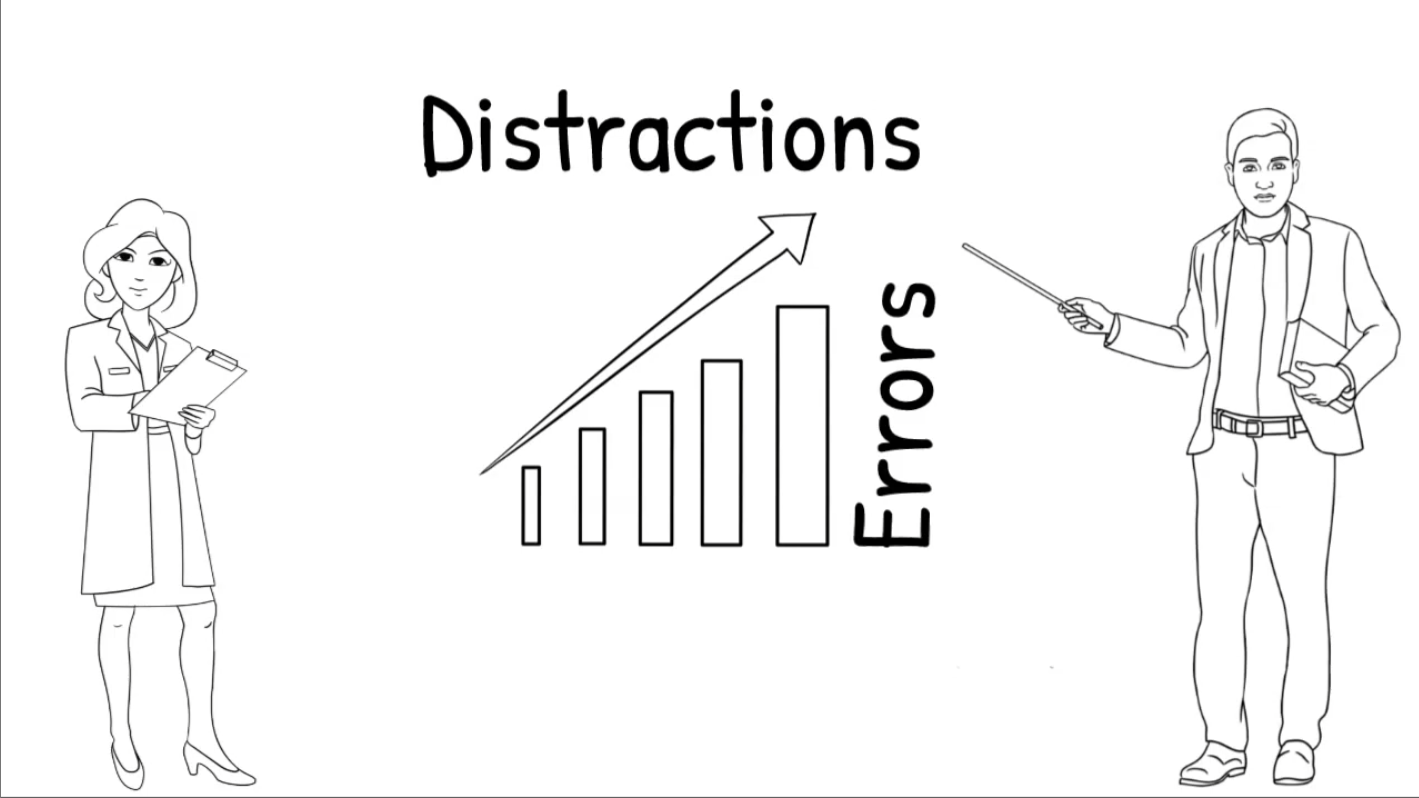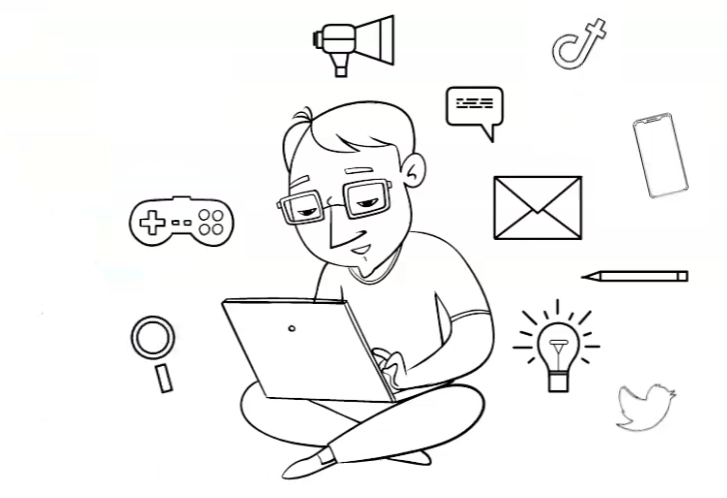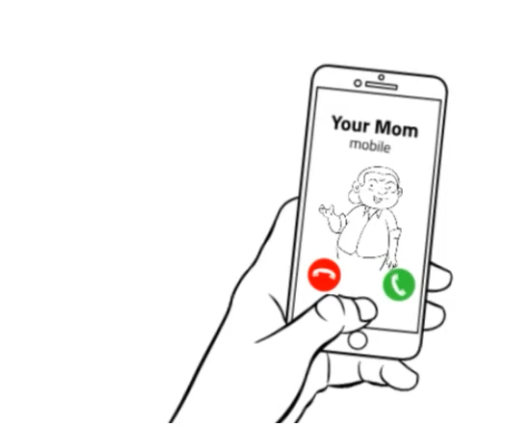Script / Documentation
Welcome back to Just Facts Academy, where you learn how to research like a genius. Remember, you don’t have to be an Einstein to be a great researcher. Just apply the 7 Standards of Credibility from our first video series, and you’ll be way ahead of the pack.
Now, we’re taking it up notch! So put your phone on silent, because today’s lesson is about <BING> distractions.

Did you know distractions cause mistakes and effectively make you dumber? That’s scary, because we live in world where constant distractions are the norm. Whether it’s a phone alert, an email, a background video, or a chatty friend—distractions are costing you much more than you probably realize.
Let’s get right to the facts of this matter and then use them to improve your research skills and the quality of almost everything you do.
First, studies have revealed that distractions exponentially increase errors. Even interruptions as brief as three seconds—according to a 2014 study in the Journal of Experimental Psychology—were enough to double the number of errors people made while completing an assigned task. And get this, the same study found that 4.4-second long interruptions caused certain errors to triple![1]

Likewise, a series of experiments published in 2008 found that “an entirely irrelevant distractor can interfere with task performance” by causing “increased error rates” and “response times.”[2]
This means distractions can not only be harmful but deadly. Think I’m exaggerating? For people working in hospitals, factories, and offices where mental sharpness or attention to detail is vital to safety or performance, mistakes can make the difference between life and death.[3]
And this is not just about mistakes. As I said before, distractions make us effectively dumber.
A 2013 study conducted at Carnegie Mellon University found that people’s comprehension skills declined by 20% if they were interrupted twice while reading a short passage. That’s enough to turn a B-minus student with a grade of 80 into a failure with a 62.[4]
Two experiments published in 2017 found that “even when people are successful at maintaining sustained attention—as when avoiding the temptation to check their phones—the mere presence of these devices reduces available cognitive capacity. Moreover, these cognitive costs are highest for those highest in smartphone dependence.”[5]

Did you catch that? The more dependent you are on your smartphone, the greater the temptation it will be, and the lower your cognitive capacity will be
And what we affectionately call “multitasking” is also a form of distraction. Even if multitasking feels comfortable and normal, studies reveal that it hurts our ability to focus on what’s important, organize our thoughts, and filter out irrelevant information.
A study published in 2009 by the Proceedings of the National Academy of Sciences found that heavy media multitasking makes people “suckers for irrelevancy,” to borrow the words of one the authors. “Everything distracts them,” he said.[6] [7] You wouldn’t happen to know anyone like that, would you?
Neuroscientists have even found physical differences in the brains of heavy multitaskers—and spoiler—it’s not for the better.[8]

So what can we do? We can’t eliminate all potential distractions, but we can minimize them. If you want to research and perform other tasks to the best of your ability, follow these simple steps:
- Set your phone to “Do Not Disturb” so it won’t even vibrate. Remember, even 2-second interruptions can hamper your efforts. Most phones allow you to choose “Favorites” who can get to through while you are in this mode, so you don’t worry about missing emergency calls or texts.
- Turn off all those pesky notifications on your computer, including emails, social media, and anything else that frequently pops up on the corner of your screen. To increase your productivity across the board, only check those several times a day.
- Make a conscious decision to stop multitasking. It’s not a skill to master, but rather a habit to break because it decreases your cognitive capacity and quality of your work.
- Consider your environment. Work in places with less distractors, like a nook in the library or a quiet room. Also, clear your desk or work area so other things aren’t pulling your eyes away from the task at hand.
- If you have a major task, resolve to work on it—and only it—for at least one uninterrupted hour at a time. As explained by Professor Gloria Mark, who specializes in the study of distractions:
When I write a research article, it takes me a couple of hours before I can even begin to think creatively. If I was switching every 10 and half minutes, there’s no way I’d be able to think deeply about what I’m doing.[9]
So get in the zone, think deeply, and be care-ful with your work. You can do all this and more if you simply decrease distractions.
So take these practical steps, put in the effort, and apply the 7 Standards of Credibility, so you can research like a genius.
Footnotes
[1] Paper: “Momentary Interruptions Can Derail the Train of Thought.” By Erik M. Altmann, J. Gregory Trafton, and David Z. Hambrick. Journal of Experimental Psychology, 2014. Pages 215–226. <https://pubmed.ncbi.nlm.nih.gov/23294345/>
Page 215:
We investigated the effect of short interruptions on performance of a task that required participants to maintain their place in a sequence of steps each with their own performance requirements. Interruptions averaging 4.4 s long tripled the rate of sequence errors on post-interruption trials relative to baseline trials. Interruptions averaging 2.8 s long—about the time to perform a step in the interrupted task—doubled the rate of sequence errors.
Page 225:
In conclusion, our core empirical finding is that when someone is momentarily interrupted or distracted and then returns to their task, they may do so without obvious hesitation, but with an increased chance of resuming at a different point in their train of thought than they might have otherwise. This contextual jitter—being taken out of the moment and landed back in a slightly different place—may be why even momentary interruptions can seem jarring when they occur during a cognitively engaging activity.
[2] Paper: “Failures to Ignore Entirely Irrelevant Distractors: The Role of Load.” By Sophie Forster and Nilli Lavie. Journal of Experimental Psychology: Applied, March 14, 2008. Pages 73– 83. <europepmc.org>
Page 73:
In daily life (e.g., in the work environment) people are often distracted by stimuli that are clearly irrelevant to the current task and should be ignored. In contrast, much applied distraction research has focused on task interruptions by information that requires a response and therefore cannot be ignored. Moreover, the most commonly used laboratory measures of distractibility … typically involve distractors that are task relevant…. A series of experiments assessed interference effects from stimuli that are entirely unrelated to the current task, comparing the effects of perceptual load on task-irrelevant and task-relevant (response competing) distractors. The results showed that an entirely irrelevant distractor can interfere with task performance to the same extent as a response-competing distractor and that, as with other types of distractors, the interfering effects of the irrelevant distractors can be eliminated with high perceptual load in the relevant task.
[3] Paper: “A New, Evidence-Based Estimate of Patient Harms Associated with Hospital Care.” By John T. James. Journal of Patient Safety, September 2013. Pages 122–128. <journals.lww.com>
Page 122:
Methods: A literature review identified 4 limited studies that used primarily the Global Trigger Tool to flag specific evidence in medical records, such as medication stop orders or abnormal laboratory results, which point to an adverse event that may have harmed a patient. Ultimately, a physician must concur on the findings of an adverse event and then classify the severity of patient harm.
Results: Using a weighted average of the 4 studies, a lower limit of 210,000 deaths per year was associated with preventable harm in hospitals. Given limitations in the search capability of the Global Trigger Tool and the incompleteness of medical records on which the Tool depends, the true number of premature deaths associated with preventable harm to patients was estimated at more than 400,000 per year. Serious harm seems to be 10- to 20-fold more common than lethal harm.
[4] Op-ed: “Brain, Interrupted. By Bob Sullivan and Hugh Thompson. New York Times, May 3, 2013. <www.nytimes.com>
We decided to investigate further, and asked Alessandro Acquisti, a professor of information technology, and the psychologist Eyal Peer at Carnegie Mellon to design an experiment to measure the brain power lost when someone is interrupted.
To simulate the pull of an expected cellphone call or e-mail, we had subjects sit in a lab and perform a standard cognitive skill test. In the experiment, 136 subjects were asked to read a short passage and answer questions about it. There were three groups of subjects; one merely completed the test. The other two were told they “might be contacted for further instructions” at any moment via instant message. …
We expected the Interrupted group to make some mistakes, but the results were truly dismal, especially for those who think of themselves as multitaskers: during this first test, both interrupted groups answered correctly 20 percent less often than members of the control group.
In other words, the distraction of an interruption, combined with the brain drain of preparing for that interruption, made our test takers 20 percent dumber. That’s enough to turn a B-minus student (80 percent) into a failure (62 percent).
[5] Paper: “Brain Drain: The Mere Presence of One’s Own Smartphone Reduces Available Cognitive Capacity.” By Adrian F. Ward and others. Journal of the Association for Consumer Research, April 3, 2017. <www.journals.uchicago.edu>
Our smartphones enable—and encourage—constant connection to information, entertainment, and each other. They put the world at our fingertips, and rarely leave our sides. Although these devices have immense potential to improve welfare, their persistent presence may come at a cognitive cost. In this research, we test the “brain drain” hypothesis that the mere presence of one’s own smartphone may occupy limited-capacity cognitive resources, thereby leaving fewer resources available for other tasks and undercutting cognitive performance.
Results from two experiments indicate that even when people are successful at maintaining sustained attention—as when avoiding the temptation to check their phones—the mere presence of these devices reduces available cognitive capacity. Moreover, these cognitive costs are highest for those highest in smartphone dependence. …
One’s smartphone is more than just a phone, a camera, or a collection of apps. It is the one thing that connects everything—the hub of the connected world. The presence of one’s smartphone enables on-demand access to information, entertainment, social stimulation, and more. However, our research suggests that these benefits—and the dependence they engender—may come at a cognitive cost.
[6] Article: “Media Multitaskers Pay Mental Price, Stanford Study Show.” By Adam Gorlick. Stanford News, August 24, 2009. <news.stanford.edu>
High-tech jugglers are everywhere—keeping up several e-mail and instant message conversations at once, text messaging while watching television and jumping from one website to another while plowing through homework assignments.
But after putting about 100 students through a series of three tests, the researchers realized those heavy media multitaskers are paying a big mental price.
“They’re suckers for irrelevancy,” said communication Professor Clifford Nass, one of the researchers whose findings are published in the Aug. 24 edition of the Proceedings of the National Academy of Sciences. “Everything distracts them.”
Social scientists have long assumed that it’s impossible to process more than one string of information at a time. The brain just can’t do it. But many researchers have guessed that people who appear to multitask must have superb control over what they think about and what they pay attention to.
Is there a gift?
So Nass and his colleagues, Eyal Ophir and Anthony Wagner, set out to learn what gives multitaskers their edge. What is their gift?
“We kept looking for what they’re better at, and we didn’t find it,” said Ophir, the study’s lead author and a researcher in Stanford’s Communication Between Humans and Interactive Media Lab.
[7] Paper: “Cognitive Control in Media Multitaskers.” By Eyal Ophir, Clifford Nass, and Anthony D. Wagner. Proceedings of the National Academy of Sciences, September 15, 2009. <www.pnas.org>
Chronic media multitasking is quickly becoming ubiquitous, although processing multiple incoming streams of information is considered a challenge for human cognition. A series of experiments addressed whether there are systematic differences in information processing styles between chronically heavy and light media multitaskers. A trait media multitasking index was developed to identify groups of heavy and light media multitaskers. These two groups were then compared along established cognitive control dimensions. Results showed that heavy media multitaskers are more susceptible to interference from irrelevant environmental stimuli and from irrelevant representations in memory. This led to the surprising result that heavy media multitaskers performed worse on a test of task-switching ability, likely due to reduced ability to filter out interference from the irrelevant task set.
[8] Paper: “Higher Media Multi-Tasking Activity Is Associated with Smaller Gray-Matter Density in the Anterior Cingulate Cortex.” By Kep Kee Loh and Ryota Kanai. PLoS One, September 24, 2014. <journals.plos.org>
Media multitasking, or the concurrent consumption of multiple media forms, is increasingly prevalent in today’s society and has been associated with negative psychosocial and cognitive impacts. Individuals who engage in heavier media-multitasking are found to perform worse on cognitive control tasks and exhibit more socio-emotional difficulties. However, the neural processes associated with media multi-tasking remain unexplored. The present study investigated relationships between media multitasking activity and brain structure. Research has demonstrated that brain structure can be altered upon prolonged exposure to novel environments and experience. Thus, we expected differential engagements in media multitasking to correlate with brain structure variability. This was confirmed via Voxel-Based Morphometry (VBM) analyses: Individuals with higher Media Multitasking Index (MMI) scores had smaller gray matter density in the anterior cingulate cortex (ACC). …
The ACC serves as a crucial nexus of information processing pathways in the brain and has been implicated in sensorimotor, nociceptive, higher cognitive and emotional/motivational processes….
An important limitation to the present work is that our results are obtained from a cross-sectional study on the relationship between media multitasking behavior and brain structure. As such, the direction of causality between them cannot be determined. Although it is conceivable that individuals with smaller ACC are more susceptible to multitasking due to weaker ability in cognitive control or socio-emotional regulation, it is equally plausible that higher levels of exposure to multitasking situations lead to structural changes in the ACC. A longitudinal study is required to unambiguously determine the direction of causation.
[9] Article: “Worker, Interrupted: The Cost of Task Switching.” By Kermit Pattison. Fast Company, July 28, 2008. <www.fastcompany.com>
Gloria Mark, Professor in the Department of Informatics at the University of California, Irvine, has some answers….
I argue that when people are switching contexts every 10 and half minutes they can’t possibly be thinking deeply. There’s no way people can achieve flow. When I write a research article, it takes me a couple of hours before I can even begin to think creatively. If I was switching every 10 and half minutes, there’s just no way I’d be able to think deeply about what I’m doing. This is really bad for innovation. When you’re on the treadmill like this, it’s just not possible to achieve flow.



